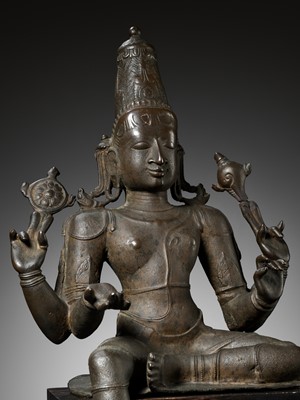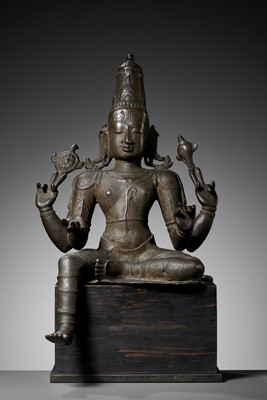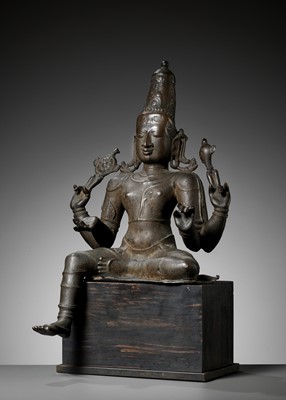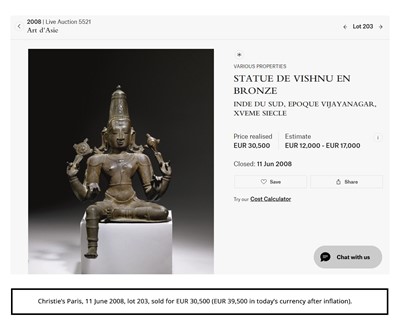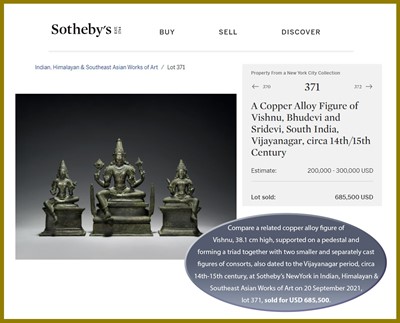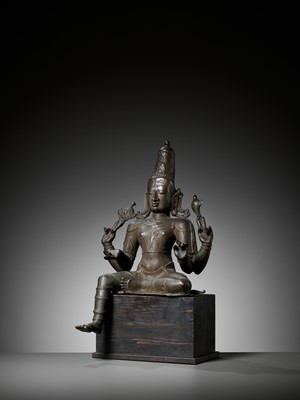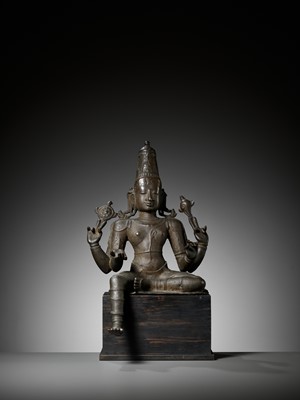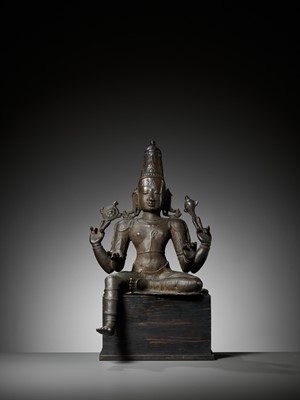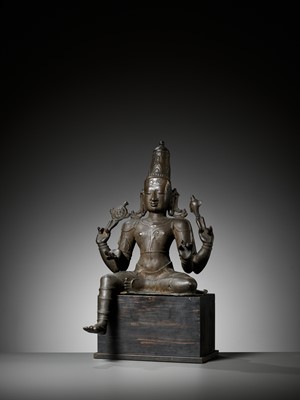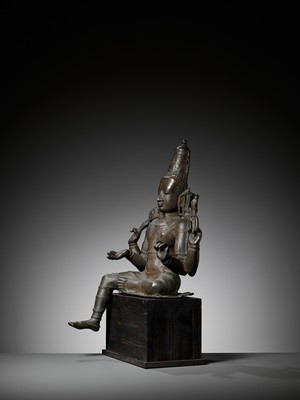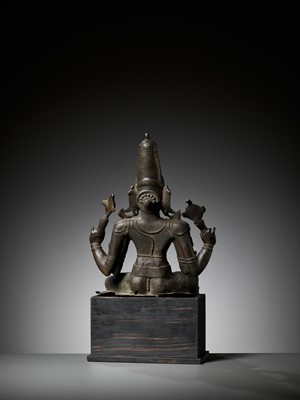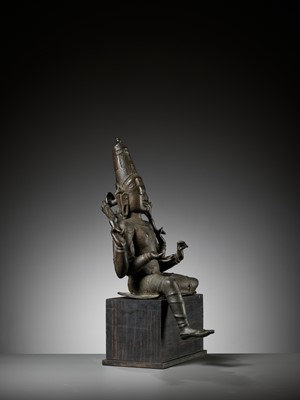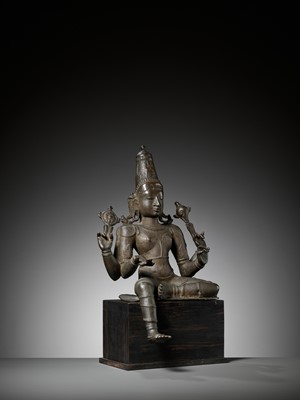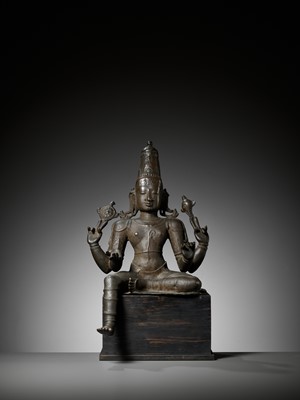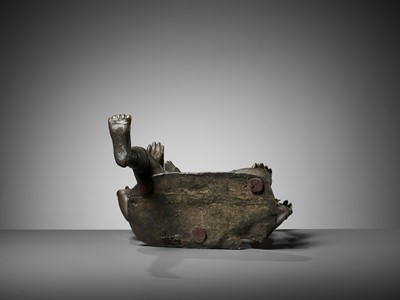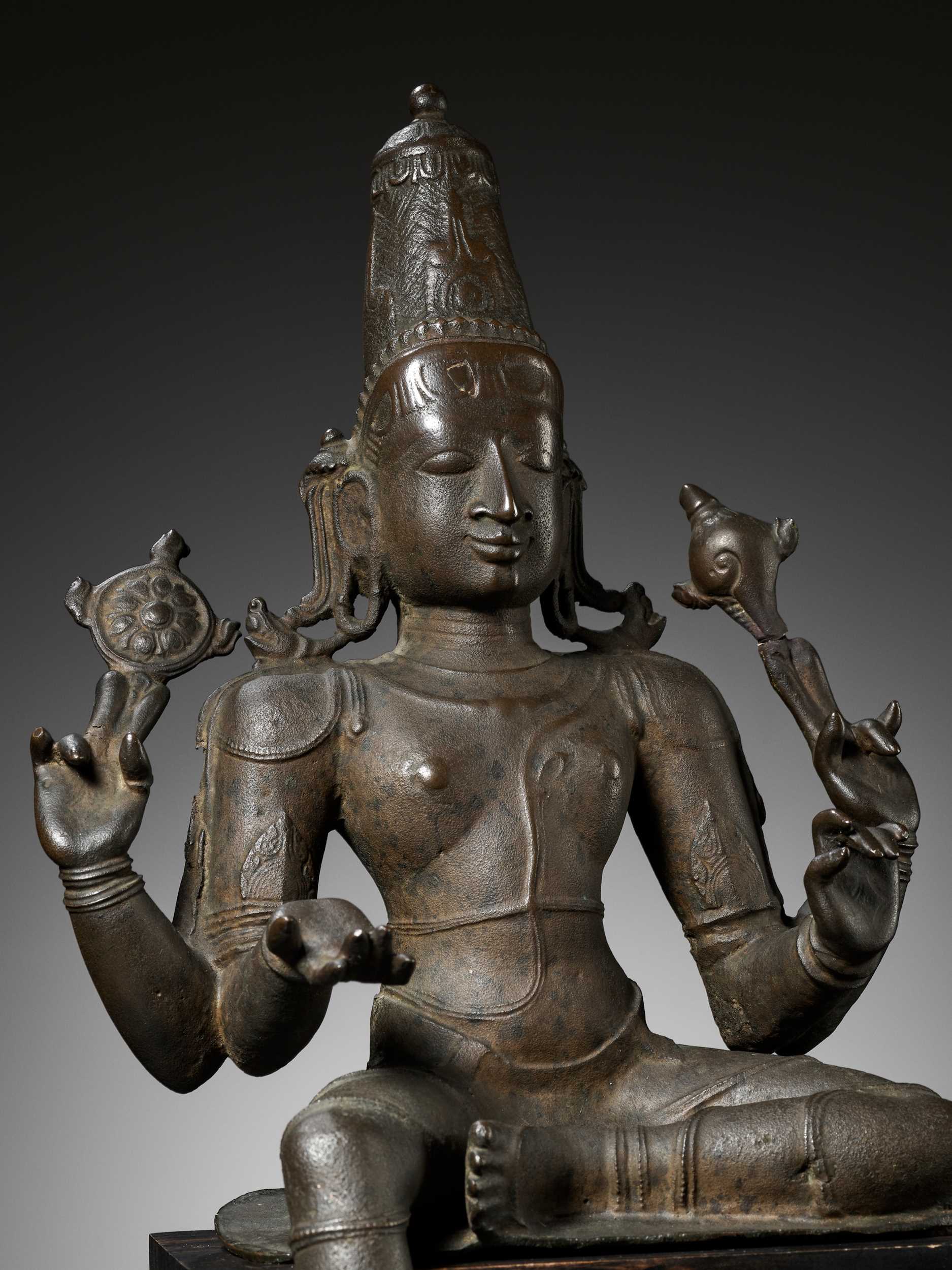11th Mar, 2022 10:00
DAY 2 - TWO-DAY AUCTION - Fine Chinese Art / 中國藝術集珍 / Buddhism & Hinduism
600
AN IMPRESSIVE BRONZE FIGURE OF VISHNU, VIJAYANAGAR PERIOD
Sold for €30,336
including Buyer's Premium
South India, 15th century. Heavily cast (total weight is 13.7 kg!), seated in lalitasana, his principal hands held in abhaya and varada mudra, his upper hands holding the wheel and conch. He is wearing a long dhoti, upavita, foliate armlets, necklaces, and tapering cylindrical crown. The serene face with almond-shaped eyes, aquiline nose, and full lips forming a benevolent smile. The present sculpture bears the telltale signs of raised edges rubbed smooth where beholders were gripped with the overt temptation to caress the figure’s face and chest.
Provenance: A private collector, acquired in 1975. Christie’s Paris, 11 June 2008, lot 203, sold for EUR 30,500 (EUR 39,500 in today’s currency after inflation). A French private collector in Paris, acquired from the above.
Condition: Excellent condition, commensurate with age. The base with a crack and small losses. The pedestal is lost. Small nicks, dents and light scratches. Signs of weathering and erosion. One of the attributes is slightly loose. Few minor further losses. Superb, naturally grown patina with a smooth feel overall. Old wear.
Weight: 13.7 kg (excl. stand)
Dimensions: Height 41 cm (excl. stand) and 45.7 cm (incl. stand)
With an associated hardwood stand mounted on a metal base. (2)
The art of the Vijayanagar period, which spanned the fourteenth through the sixteenth centuries in South India, shows continuity with the earlier styles of the Chola Dynasty (9th-13th centuries). As the Muslim forces established rule in Northern India in the thirteenth century, the South defiantly reaffirmed their commitment to Hindu ideals and practices. The main city bearing the name of the period, Vijayanagar, or “City of Victory”, is a declaration of the South’s triumph in overcoming a period of considerable chaos caused by the Northern invaders, and their link to the successful Chola dynasty was an affirmation that political, economic and cultural success would continue.
Unlike the naturalism present in the sculptures from the Chola dynasty, Vijayanagar bronzes are more heavily stylized in line, texture and design. The naturalism of the previous era is replaced with a still and motionless quality, as if the figures were frozen in time. The faces and bodies are frontal and straight, every detail is arranged with deliberateness. Although the figures still retain corporeal suppleness, the style is mannered and intentional.
Seated manifestations of the four-armed Vishnu with one leg pendant are extremely rare to encounter in bronze. Normally he is depicted standing. However, in a few avatars or incarnations of for instance Narasimha and Varaha one might find him in seated position. The reason for this particular phenomenon in bronze is not clear. On the other hand in stone he is represented regularly seated with one leg pendant. The more archaic rendering of this particular Vishnu bronze suggests a late date for its creation, around the fifteenth century.
Auction result comparison: Compare a related copper alloy figure of Vishnu, 38.1 cm high, supported on a pedestal and forming a triad together with two smaller and separately cast figures of consorts, also dated to the Vijayanagar period, circa 14th-15th century, at Sotheby’s New York in Indian, Himalayan & Southeast Asian Works of Art on 20 September 2021, lot 371, sold for USD 685,500.
South India, 15th century. Heavily cast (total weight is 13.7 kg!), seated in lalitasana, his principal hands held in abhaya and varada mudra, his upper hands holding the wheel and conch. He is wearing a long dhoti, upavita, foliate armlets, necklaces, and tapering cylindrical crown. The serene face with almond-shaped eyes, aquiline nose, and full lips forming a benevolent smile. The present sculpture bears the telltale signs of raised edges rubbed smooth where beholders were gripped with the overt temptation to caress the figure’s face and chest.
Provenance: A private collector, acquired in 1975. Christie’s Paris, 11 June 2008, lot 203, sold for EUR 30,500 (EUR 39,500 in today’s currency after inflation). A French private collector in Paris, acquired from the above.
Condition: Excellent condition, commensurate with age. The base with a crack and small losses. The pedestal is lost. Small nicks, dents and light scratches. Signs of weathering and erosion. One of the attributes is slightly loose. Few minor further losses. Superb, naturally grown patina with a smooth feel overall. Old wear.
Weight: 13.7 kg (excl. stand)
Dimensions: Height 41 cm (excl. stand) and 45.7 cm (incl. stand)
With an associated hardwood stand mounted on a metal base. (2)
The art of the Vijayanagar period, which spanned the fourteenth through the sixteenth centuries in South India, shows continuity with the earlier styles of the Chola Dynasty (9th-13th centuries). As the Muslim forces established rule in Northern India in the thirteenth century, the South defiantly reaffirmed their commitment to Hindu ideals and practices. The main city bearing the name of the period, Vijayanagar, or “City of Victory”, is a declaration of the South’s triumph in overcoming a period of considerable chaos caused by the Northern invaders, and their link to the successful Chola dynasty was an affirmation that political, economic and cultural success would continue.
Unlike the naturalism present in the sculptures from the Chola dynasty, Vijayanagar bronzes are more heavily stylized in line, texture and design. The naturalism of the previous era is replaced with a still and motionless quality, as if the figures were frozen in time. The faces and bodies are frontal and straight, every detail is arranged with deliberateness. Although the figures still retain corporeal suppleness, the style is mannered and intentional.
Seated manifestations of the four-armed Vishnu with one leg pendant are extremely rare to encounter in bronze. Normally he is depicted standing. However, in a few avatars or incarnations of for instance Narasimha and Varaha one might find him in seated position. The reason for this particular phenomenon in bronze is not clear. On the other hand in stone he is represented regularly seated with one leg pendant. The more archaic rendering of this particular Vishnu bronze suggests a late date for its creation, around the fifteenth century.
Auction result comparison: Compare a related copper alloy figure of Vishnu, 38.1 cm high, supported on a pedestal and forming a triad together with two smaller and separately cast figures of consorts, also dated to the Vijayanagar period, circa 14th-15th century, at Sotheby’s New York in Indian, Himalayan & Southeast Asian Works of Art on 20 September 2021, lot 371, sold for USD 685,500.
Zacke Live Online Bidding
Our online bidding platform makes it easier than ever to bid in our auctions! When you bid through our website, you can take advantage of our premium buyer's terms without incurring any additional online bidding surcharges.
To bid live online, you'll need to create an online account. Once your account is created and your identity is verified, you can register to bid in an auction up to 12 hours before the auction begins.
Intended Spend and Bid Limits
When you register to bid in an online auction, you will need to share your intended maximum spending budget for the auction. We will then review your intended spend and set a bid limit for you. Once you have pre-registered for a live online auction, you can see your intended spend and bid limit by going to 'Account Settings' and clicking on 'Live Bidding Registrations'.
Your bid limit will be the maximum amount you can bid during the auction. Your bid limit is for the hammer price and is not affected by the buyer’s premium and VAT. For example, if you have a bid limit of €1,000 and place two winning bids for €300 and €200, then you will only be able to bid €500 for the rest of the auction. If you try to place a bid that is higher than €500, you will not be able to do so.
Online Absentee and Telephone Bids
You can now leave absentee and telephone bids on our website!
Absentee Bidding
Once you've created an account and your identity is verified, you can leave your absentee bid directly on the lot page. We will contact you when your bids have been confirmed.
Telephone Bidding
Once you've created an account and your identity is verified, you can leave telephone bids online. We will contact you when your bids have been confirmed.
Classic Absentee and Telephone Bidding Form
You can still submit absentee and telephone bids by email or fax if you prefer. Simply fill out the Absentee Bidding/Telephone bidding form and return it to us by email at office@zacke.at or by fax at +43 (1) 532 04 52 20. You can download the PDF from our Upcoming Auctions page.
How-To Guides
How to Create Your Personal Zacke Account
How to Register to Bid on Zacke Live
How to Leave Absentee Bids Online
How to Leave Telephone Bids Online
中文版本的操作指南
创建新账号
注册Zacke Live在线直播竞拍(免平台费)
缺席投标和电话投标
Third-Party Bidding
We partner with best-in-class third-party partners to make it easy for you to bid online in the channel of your choice. Please note that if you bid with one of our third-party online partners, then there will be a live bidding surcharge on top of your final purchase price. You can find all of our fees here. Here's a full list of our third-party partners:
- 51 Bid Live
- EpaiLive
- ArtFoxLive
- Invaluable
- LiveAuctioneers
- the-saleroom
- lot-tissimo
- Drouot
Please note that we place different auctions on different platforms. For example, in general, we only place Chinese art auctions on 51 Bid Live.
Bidding in Person
You must register to bid in person and will be assigned a paddle at the auction. Please contact us at office@zacke.at or +43 (1) 532 04 52 for the latest local health and safety guidelines.
